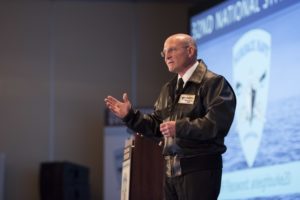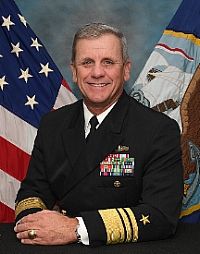SAN DIEGO— Top Navy officials defended the service’s carrier strike group readiness generation model after the Secretary of Defense dismissed its usefulness, but said they are open to modifying it.
Speaking before a House Armed Services Committee hearing last week, Secretary of Defense Mark Esper said delays in releasing the 30-year shipbuilding plan and Integrated Naval Force Structure Assessment (INFSA) are tied to re-examining things like the Optimized Fleet Response Plan (OFRP) and discussing future Navy plans with outside analysts so he can present Congress a more defensible total plan.

“There are some questions with regard to the INFSA that I have that I’m concerned about,” he said. “An assumption in the INFSA is that the OFRP works. The OFRP hasn’t worked for years, so why should we assume that it will work in the future?”
Chief of Naval Operations (CNO) Adm. Michael Gilday disagreed with Esper’s characterization here at the annual AFCEA West 2020 conference on March 2.
“I don’t necessarily agree with the secretary’s assessment, and I say that with all due respect. But we have made and are projecting into the future to continue to meet every commitment, every deployment that we’ve been directed to do,” Gilday said here.
The OFRP was first instituted in 2013 and seeks to maximize ship employment for combatant commanders while increasing readiness and preserving maintenance and training. Under OFRP, aircraft carriers have a 36-month cycle made of combined 14 months for maintenance and training cycles and about 22 months where they deploy for seven to eight months and then sustain readiness by deploying again or being held as a surge force.
Gilday said in his previous position as director of operations for the Joint Staff he saw how OFRP and the Navy’s ability to project forces forward and surge forces in an emergency would affect the whole military force.
The CNO said when he took over last August he immediately asked U.S. Fleet Forces Command and the Pacific Fleet to conduct an assessment of OFRP since “it has been five or six years since we put it into place, and I had questions myself coming out of the Joint Staff on plans that I had observed that, at a minimum, I thought we were going to have to buy more surge.”
“Secretary Esper asked for a separate, independent assessment of OFRP. That’s ongoing,” Gilday added.
, with the top fleet commanders in the Atlantic and Pacific due to report to the CNO “in the coming months” (Defense Daily, Nov. 4, 2019).
Burke said while OFRP is meant to be optimized it was optimized in 2012 around different objectives.
He said the Navy was “very open to making changes to that readiness plan and and we’ve taken it down to the fundamental assumptions and principles of it and what do we have to do differently to look at it.”
“Part of that is you can’t use up that wartime capacity for things short of war and wish you had it when you need it later. So we’re going to have to do a little bit of an appetite suppressant on how many carriers we’re able to provide,” Burke added.
“I think at the end of the day, what we have to do is understand what the Secretary of Defense really wants with respect to either increased presence today or increased surge is a combination of both of those,” Gilday said Monday.
Gilday said he generally thinks OFRP as a 36-month cycle is working alright and noted the National Defense Strategy calls for being able to deter conflict by maintaining a credible surge force.
He admitted in the past combatant commanders had been so keen on presence that they ate up surge capacity by requiring double deployments during a ship’s sustainment phase. Moreover, the maintenance portion of OFRP has been challenged by budget issues like continuing resolutions and workforce shortages at maintenance yards. However, he said the Navy is working hard to resolve those issues.
Vice Adm. Richard Brown, Commander of Naval Surface Forces and Naval Surface Force, U.S. Pacific Fleet, agreed with the CNO.
“Just because we’re looking at OFRP doesn’t mean that OFRP is broken, and premier organizations reassess themselves and they ask themselves really hard questions. I think the United States Navy is a premier organization and so everything that we do we need to go and look at it,” Brown told reporters here on Monday.
Brown favors the predictive aspects of OFRP.

“OFRP provides predictive presence. You’re going to generate this many ready forces at this time to go forward deployed. And then you have this many ready forces in reserve to surge if you need them to surge. So I like it. And now, as long as you maintain that type of model, I’m always in support of it,” he continued.
Brown compared the current plan to the issues before OFRP.
“Prior to OFRP, especially after 9/11 and then prior to OFRP, there was great concern about how much we were employing the aircraft carriers and were we burning the readiness out of the aircraft carriers.”
Brown was commander of the USS Gettysburg (CG-64) from 2007-2009 and underscored “I was underway every month that I had command of that ship except for March of ‘08 and September of ‘09. Three deployments – that doesn’t happen under OFRP now.”
Now leaders can decide “with malice aforethought” whether to use the surge forces produced by OFRP that otherwise reduce readiness.
“If you surge a ship that’s in sustainment, you’re burning readiness and you have to reset that readiness. But we need to have that surge capability in case we need to start off surge operations,” Brown added.